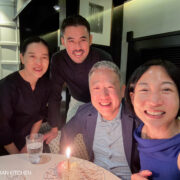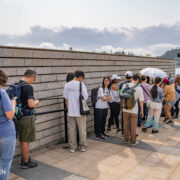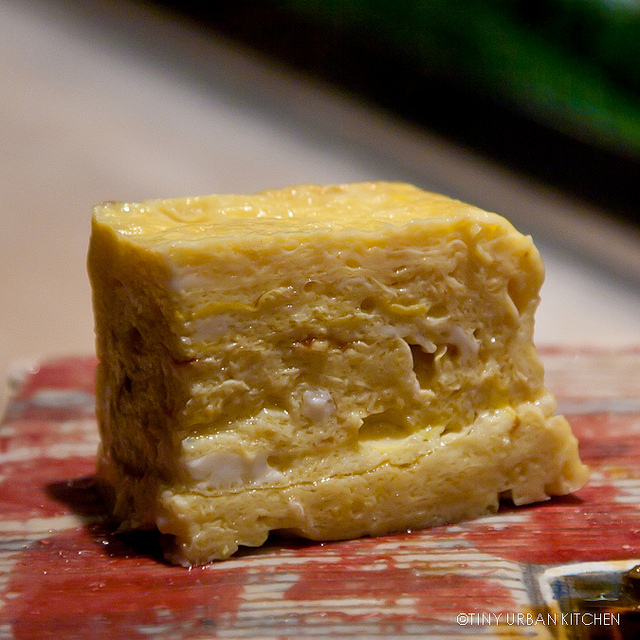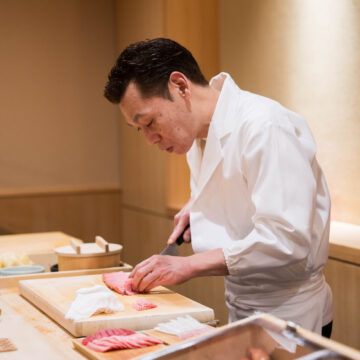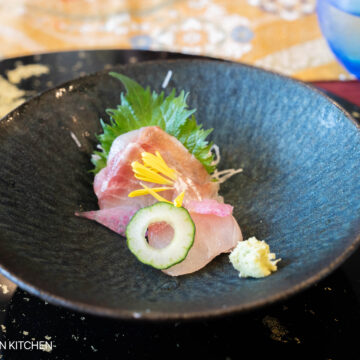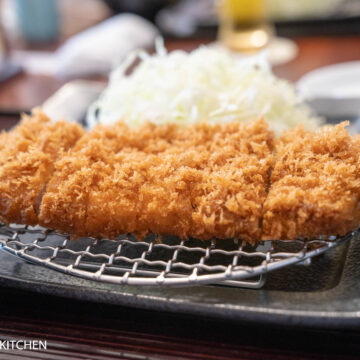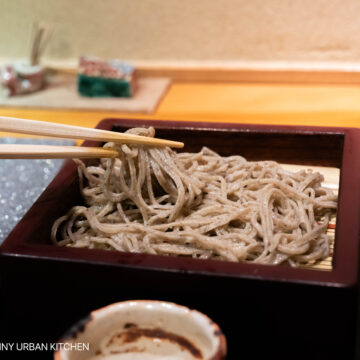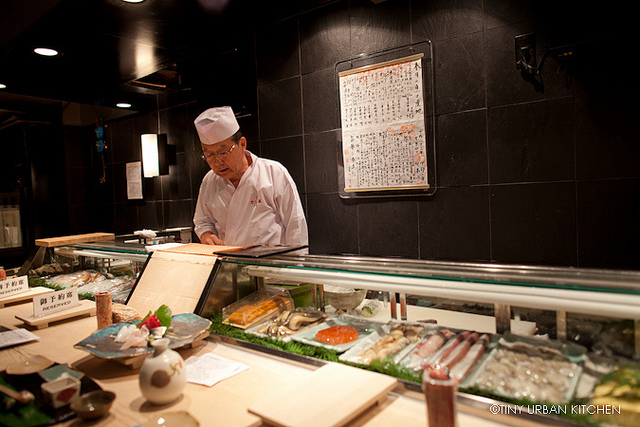
This is part 2 of my latest travel series: Post Quake Japan. Other posts in this series: Kago
Wasabi lured Bryan into liking Japanese cuisine.
Bryan was never a natural fan of Japanese food. Unlike me, who ate it voraciously growing up, Bryan was put off by many traditional Japanese flavors (think bonito, seaweed) and only grudgingly ate it.
Until he discovered wasabi.
Bryan has always loved anything spicy - everything from habaneros to horseradish. When he first started eating sushi, he consistently overwhelmed his tiny soy sauce tray with huge dollops of wasabi, mixing in bare minimum drops of soy sauce to form a super thick paste. I seriously doubt he could even tell what fish he was eating (though he totally claims he could). But hey, I was happy we could finally go out to eat Japanese.
More recently on a trip to Japan, we learned the intricacies about eating sushi and the role wasabi plays. Sushi chefs are quite particular about when to use wasabi, when not to use it, and how much to use. Our palates have gradually become more refined as we've learned the art of appreciating sushi in Japan.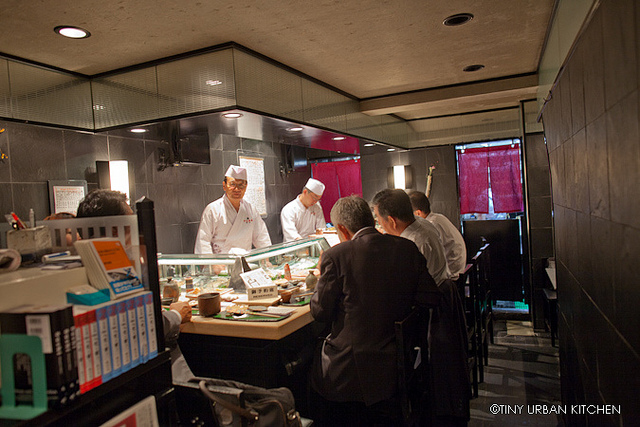
With these newly acquired lessons in our heads, our first stop after landing in Japan was (of course) sushi. We made reservations at this tiny 8-seater restaurant in Shimbashi (not too far from the chicken sashimi place!) called Daisan Harumi. Daisan Harumi is super popular on Japanese forums and review sites because of its high quality of sushi and reasonable prices (at least when compared to high end sushi).
Better yet? They make some fine wasabi. According to the chef (mind you this is in Japanese so I can only hope I understood everything correctly), Hashido-san (one of the chefs) recently won 1st place in a prestigious wasabi contest.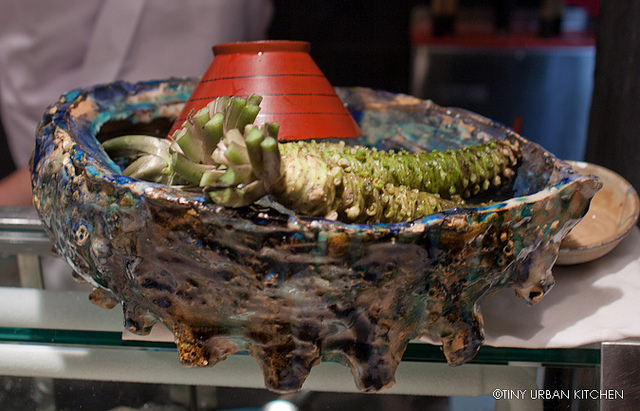
fresh wasabi root
There's one thing you might not know about wasabi - "real" Japanese wasabi (wasabia japonica) is difficult to cultivate and very expensive. The roots can cost anywhere from $70 to $100 a pound, and they are in very high demand in Japan. It's also super difficult to find in the US. On this side of the world, "wasabi" is made from a mixture of normal horseradish (less than $1/lb!), mustard, and green food coloring. In Japan, they call this "western" wasabi seiyō wasabi.
At Daisan Harumi, not only did we get the opportunity to taste "real" wasabi, we had the privilege of watching them make it right in front of our eyes! The sushi chef cuts a portion of the root off, grates it, and then hands you the fresh, bright green paste immediately. You couldn't ask for fresher wasabi than that!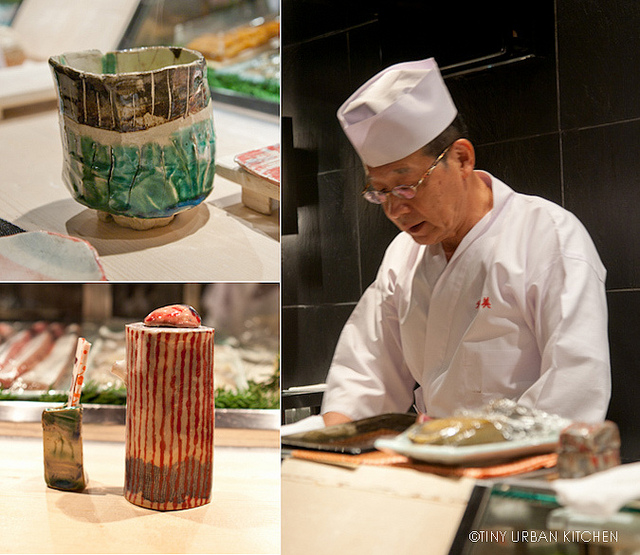
This was, of course, just the start of a fun and entertaining meal.Meet Chef Kazuo Nagayama, who has been making sushi for over 40 years. He's sort of a Jack of All Trades. He's into pottery, calligraphy, food, and writing, just to name a few. Much of the eclectic dishware at the sushi bar are handmade by Nagayama-san himself. Even the chopsticks wrappers are hand-folded out of traditional Japanese paper.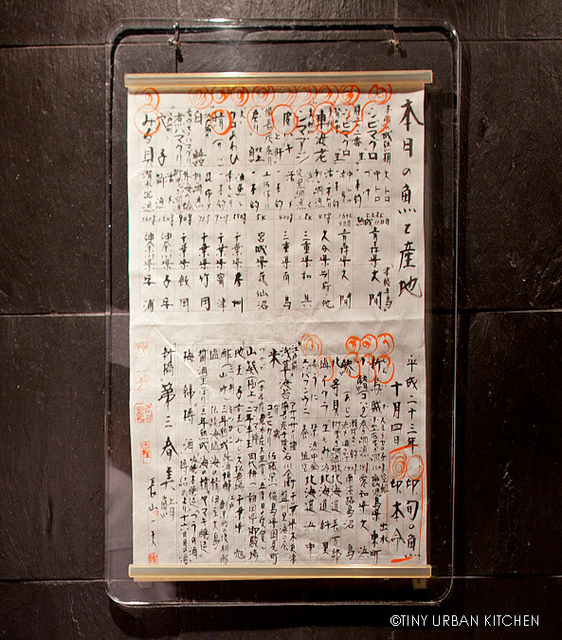
The menu changes daily (depending on what's fresh and available), and Chef Nagayama hand writes the menu with a paintbrush on sumi rice paper every day. It takes him over an hour to do this painstaking task, but the result is beautiful. Better yet, he gives you a gorgeous copy (that's also on the same rice paper) to take home with you.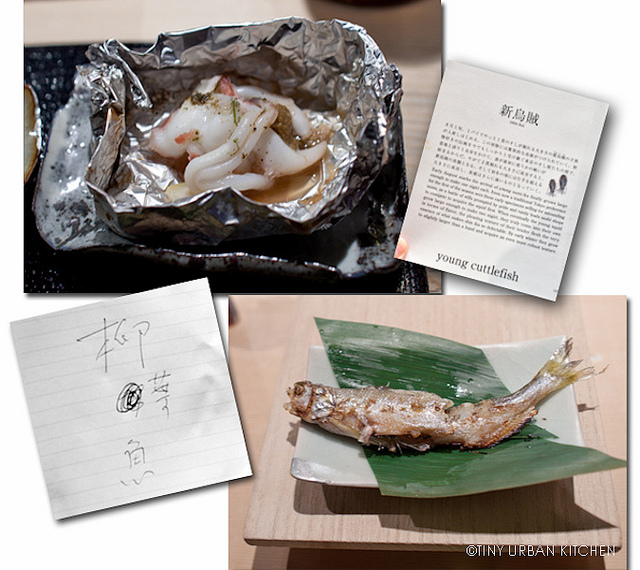
Chef Nagayama has written various books, including a useful bilingual guide that describes all different types of fish. In fact, whenever we didn't understand the Japanese name for a particular fish, Chef Nagayama or one of his assistant would bring out the correct page from the book and set it on our table.
Sometimes, as in the case above, he had no book page, so he would have to hand write it. I actually can't read what he wrote - can anyone translate?
Our meal began with a warm, baked shin ika (young cuttlefish fish) with liver in the middle. It was hot, cooked, and quite fresh, with just a slightly rubbery texture. I'm not a huge fan of liver, so I only thought it was OK. We then had shishamo, the whole fried fish (including the head! - slightly squeamish but I got over it).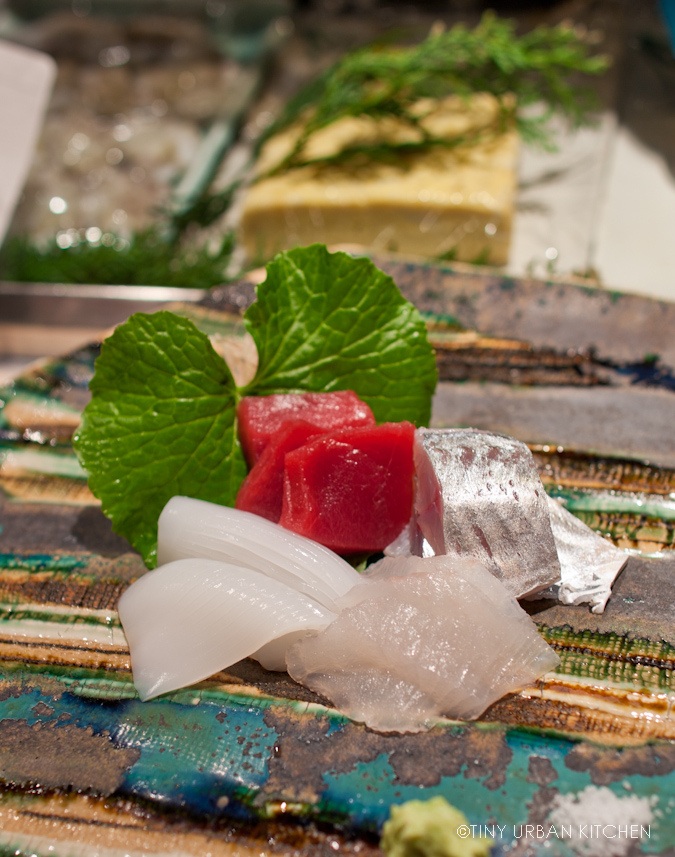
We ordered the omakase (let the chef decide!) with both sashimi and sushi. They always start with sashimi first. In this case (unlike the higher end places which literally give you one piece at a time), Chef Nagayama handed us a plate with various fresh slices - kawahagi with liver sauce (thread sail file fish); aji with ginger sauce (horse mackerel); ika (cuttlefish) and maguro (tuna) with wasabi.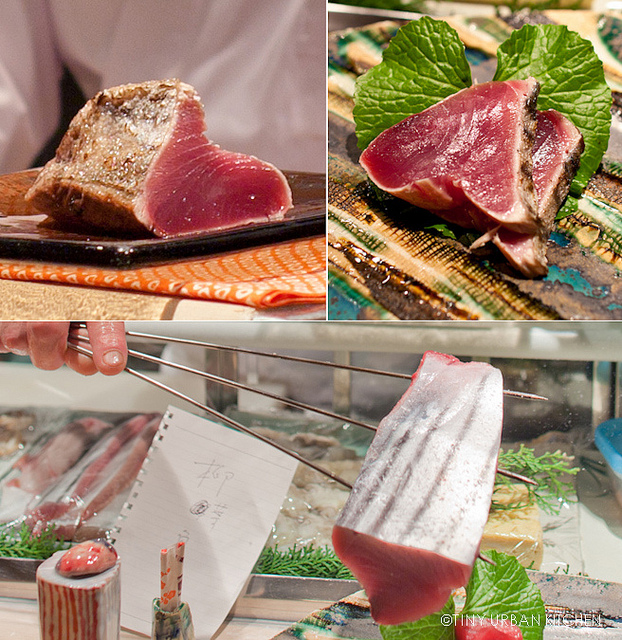
The next item was one of my favorite items of the whole night. Nagayama's assistant briefly fired up a gorgeous cut of katsuo (bonito or skipjack tuna) on a skewer. This was insanely good. I loved the interplay between the slightly torched, salted edge and the tender, soft raw center. We dipped the slices first in ponzu sauce and then add lots of wasabi. According to the chef, the fattier the fish, the more wasabi one should add. In this case, since katsuo was a very fatty fish, we should add "many wasabi."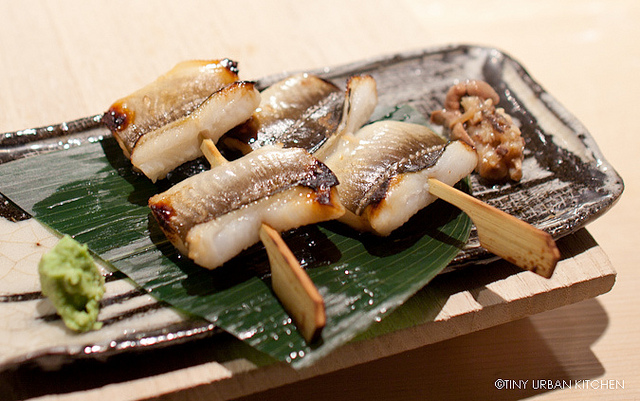
We had some lovely marinated kohada (gizzard shad) on skewers. These were tender and almost "popped" with juicy-ness when you bit into it.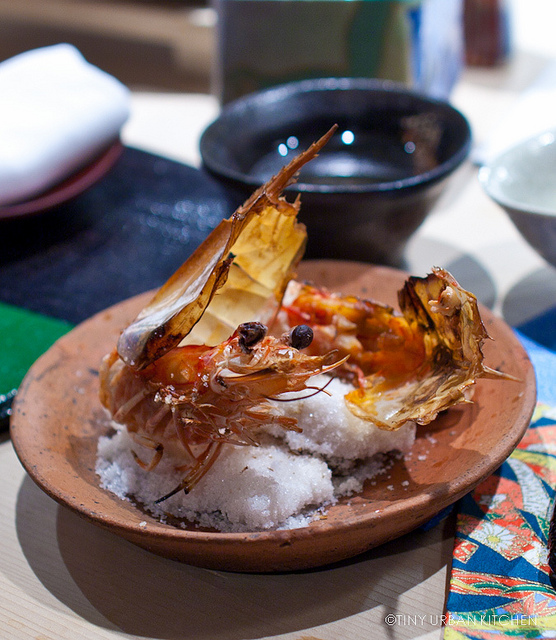
These scary looking fried prawn "skins" weirded me out because the eyes were right there! Although it was delicate, crispy, and had a nice shrimp flavor, I was so squeamish that I probably didn't enjoy this as much as I might have had I not known what I was eating!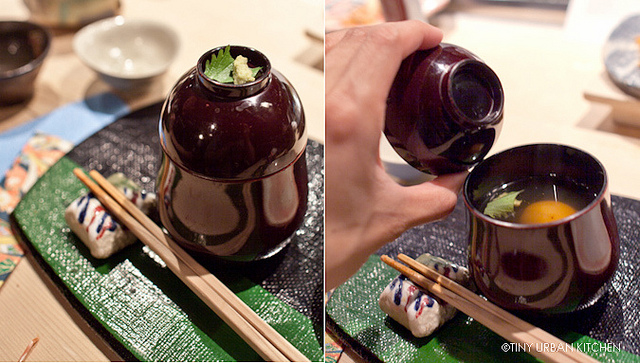
As the non-sushi part of the omakase came to a close, we had a sour ume (plum) soup (with a tiny shiso leaf and wasabi on top) to cleanse the palate.
Then the sushi started coming, one piece at a time. Anago (#1 - freshwater eel, also known as conger) was in season at the time. It was smooth, melt-in-your-mouth soft, slightly sweet, and succulent. Chutoro (#4 - fatty tuna belly) was phenomenal, as always.
Daisan Harumi is supposedly famous for its amazing mackerel, and this beautiful slice of saba (#2 - mackerel), did not disappoint at all. It was perfectly vinegared, brushed ever-so-slightly with a kiss of soy sauce, and was melt-in-your mouth soft. Kuruma ebi (#3 - Japanese tiger prawn) was pretty good, although I remember telling Bryan that I though the one at Kyubey was much better (ahem, could that be because they freshly kill their shrimp?)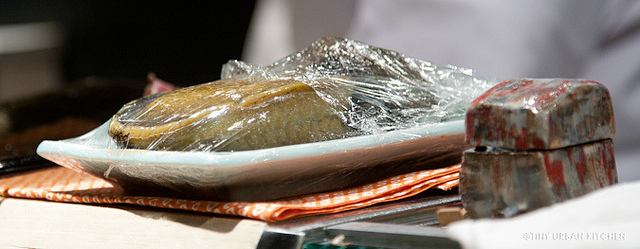
Abalone was sweet and tender with its characteristic rubbery texture.
The few times I tried geoduck in America, I did not love it because I thought it had some off flavor I really didn't like. Suprise! The geoduck in Japan (mirugai) was fresh, sweet, and did not have any hints of "off" flavors (upper left photo). The texture was a bit different than fish - a bit more firm, like squid. Shirokisu (Japanese whiting - bottom left) was clean tasting, and the uni (bottom right) was rich and creamy - not a hint of stinkyness.
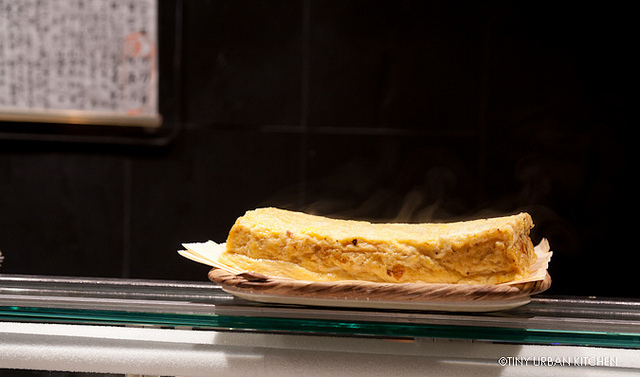
Near the end of the meal, they brought out this gorgeous, steaming hot tamago (sweet egg).
Many think that one can judge how good a sushi restaurant by the quality of its tamago. The tamago here was fluffy, moist, sweet, and just slightly creamy. Although not as refined and delicate as the one at Sushi Kanesaka, it was nonetheless excellent, and I definitely enjoyed every bite of it.
We ended with a simple gelatin-based dessert that was a nice palate cleanser after such an intense meal!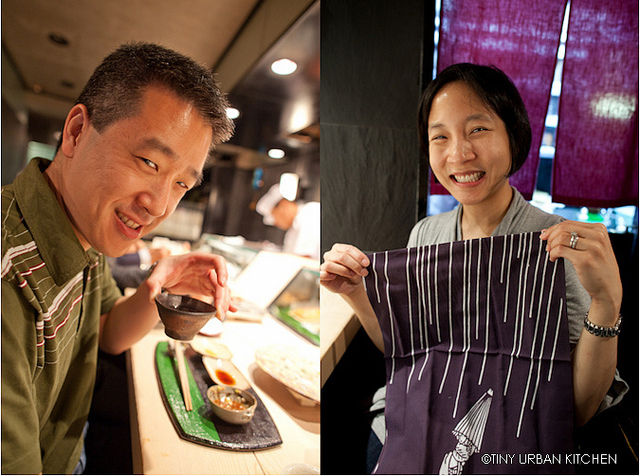
You get many parting gifts. I already mentioned the handwritten menu and handmade chopsticks wrappers. Nakayama-san also gives all the ladies a pretty furoshiki, a wrapping cloth that can be used to carry your bento, wrap a gift, or even wear as a scarf! Isn't it pretty? 🙂
Thoughts
I can see why Daisan Harumi is popular. Chef Nagayama really cares about his craft, and his sushi and sashimi are excellent. My favorites? Definitely the torched katsuo, saba, and toro. There's a bit more liver than I'd personally prefer, so perhaps I would tell him next time if I ordered omakase again. Bryan thought the execution of the sushi was not at the same level as the top, high-end places. Nevertheless, the fish is super fresh; the atmosphere is cozy; and the eclectic touches from Nagayama-san make this restaurant really unique. The prices are quite good for the quality. If you really want a deal, come on Saturdays, when lunch and dinner are priced the same (around 4,000 yen for sashimi, for example). Kawashima-san, Nagayama's longtime assistant, will take good care of you.
Daisan Harumi
Nearest Subway Stop: Shimbashi
Lunch: 6000 - 7000 yen
Dinner: 15,000-20,000 yen
Mon-Fri 11:30am-1:30pm, 5:30pm-10:30pm;
Sat 11:30am-1:30pm, 5:30pm-9:00pm;
closed Sun
1-17-7 Shinbashi, Minato-ku, Tokyo
All Rights Reserved




